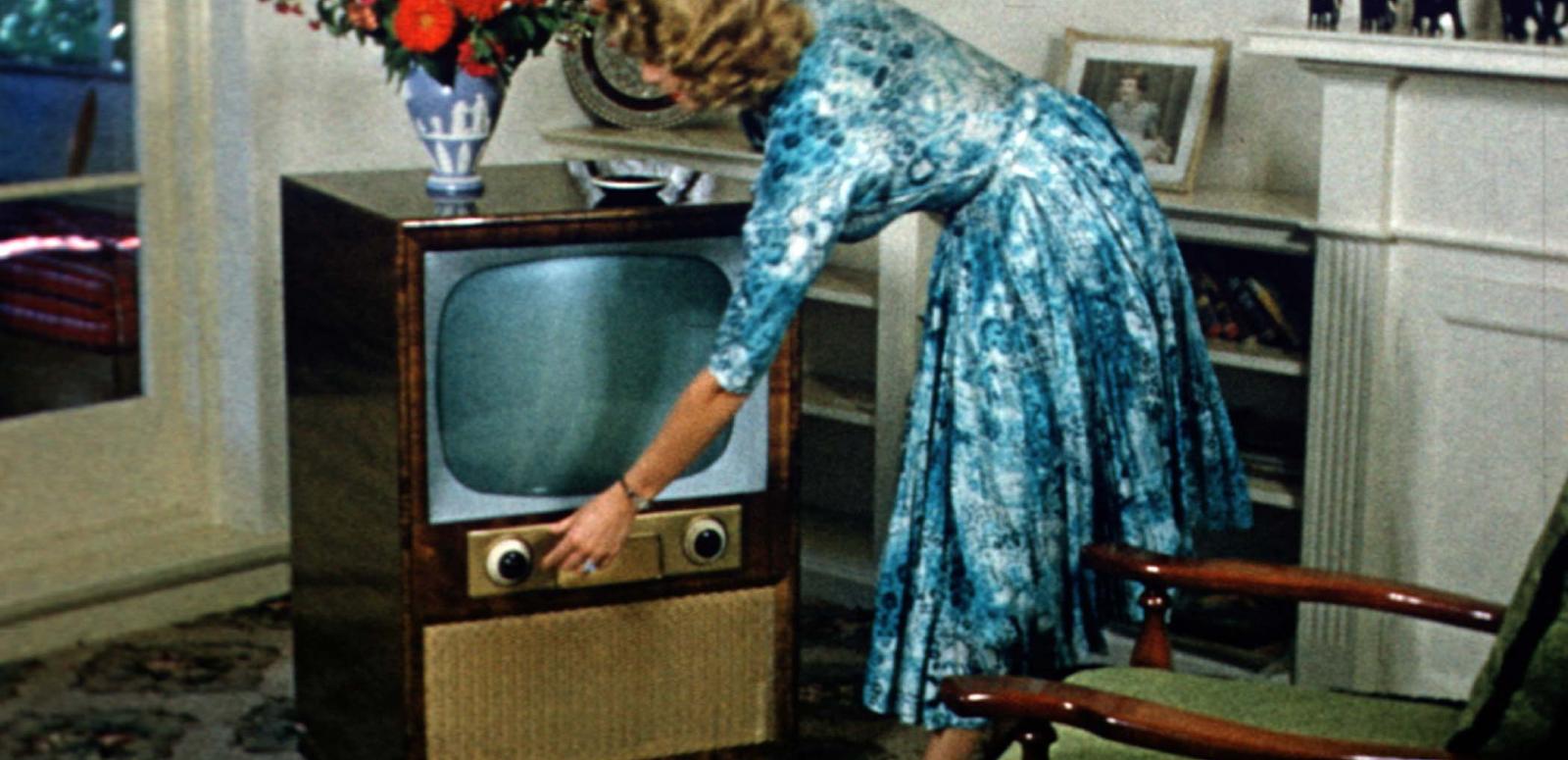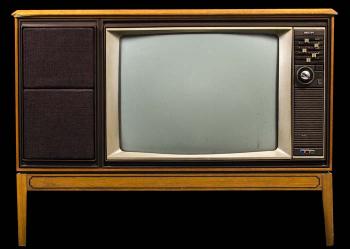Part 1 of our 2-part feature. Read Part 2
The colour TV revolution hit Australia on 1 March 1975. Curator Bronwyn Barnett explains what was involved in reaching this milestone – and why it took so long.

Part 1 of our 2-part feature. Read Part 2
The colour TV revolution hit Australia on 1 March 1975. Curator Bronwyn Barnett explains what was involved in reaching this milestone – and why it took so long.

The journey to 1975’s ‘C-day’, as it was known, started many years earlier.
Colour television began in the USA in 1954 and colour television equipment manufacturers visited Australia to demonstrate their product as early as 1962–63. An interview with Prime Minister Robert Menzies at Sydney Showgrounds was captured by EMI colour cameras.1
In the 1960s, Australia was involved in the Vietnam War which, by the early 1970s, had placed a heavy burden on the Australian economy.
According to Bruce Gyngell, then head of the Seven Network, Australia’s involvement in the Vietnam War also delayed the arrival of colour television in Australia:
Excerpt from Bruce Gyngell's Oral History interview with Brendan Horgan, 1998. NFSA title: 382977
Other reasons for the delay were more technical. Australian broadcast and manufacturing industries, along with the Postmaster-General’s Department, were researching the most suitable colour standard for Australia. Colour television had already been established in various other countries: the US used NTSC; the Germans, PAL; the French, SECAM; and the Russians were developing systems similar to SECAM known as SECAM 111A and SECAM IV (NIR).
The International Radio Consultative Committee was trying to set an international colour standard at the 1966 Oslo Convention, but ‘found it impossible to recommend a single worldwide colour television system’ because each system was backed by countries affiliated politically with the systems’ producers2. A FACTS (Federation of Australian Commercial Television Stations) report suggests the general consensus amongst the Australian industries was for PAL3.
Postmaster-General Alan Hulme advised the government in 1966 that, ‘Consideration of all the factors relevant to the matter including the experience of overseas countries in colour television suggests the desirability of a cautious approach’4. The Postmaster-General did not announce PAL as the Australian colour standard until 27 February 1969, finding that PAL would provide greater colour stability and better results under poor reception conditions. Confirmation of the colour standard enabled television stations to implement their plans for conversion.
ATV-O is generally considered the first station to broadcast colour television in Australia. It acquired a $100,000 RCA color camera and trialled it at the Pakenham races on 15 June 1967. The broadcast was not transmitted to the public but viewed on closed-circuit monitors at ATV’s Nunawading studios for owner Reg Ansett and ATV executives, Australian Broadcasting Control Board (ABCB) representatives and the press.
Even before the Postmaster-General had settled on a colour standard, TV stations set up displays at agricultural shows and shopping centres to educate audiences on the advantages of colour television. Brisbane’s Channel 7 screened this short film as part of their demonstration at the Ekka (Royal Queensland Show) in 1967:
From 50 Years of Channel 7; BTQ7 50th Anniversary Station IDs, 2009. Courtesy: Channel 7 Brisbane. NFSA title: 807463
On 15 February 1972, Prime Minister William McMahon announced that colour transmission would commence on 1 March 1975.
One of the biggest government considerations was tariff protection on the manufacture of colour television sets. On commencing office in December 1972, Prime Minister Gough Whitlam ordered an Inquiry into Colour Television to consider whether protection should be granted to local manufacturers and what protections would be needed to sustain the production of local content. Australians were subsidising the local manufacture of black-and-white television sets by an average of $100 and, with the advent of colour, local manufacturers were lobbying for even higher protections:
From Federal File 73/63, 1973. Courtesy: Nine Network. NFSA title: 15681
Broadcasters believed lower tariffs would encourage viewers to switch to colour. The higher the uptake of colour sets, the more advertisers would invest in making colour commercials which would then offset the enormous conversion cost to broadcasters (estimated in 1972 by the ABCB to be $116 million). If tariffs made the cost of colour televisions too high, ‘the economics are such that it could be unattractive for commercial operators like ourselves (Tasmanian Television Ltd, TVT-6) to go into colour early’.5
Channel Seven’s Graham Foster describes what was required for television stations to convert from black-and-white to colour, giving an insight into why the cost to broadcasters was so high:
Excerpt from Graham Foster's Oral History interview with John Fife, 2013. NFSA title: 1104332
With insight provided by other countries already broadcasting in colour, the Australian government was able to set standards for both local and imported television sets and components. The standards were to address concerns about radiation and the flammability of colour TVs:
From Federal File 73/63, 2 December 1973. Courtesy: Nine Network. NFSA title: 15682
Advertisements for ‘colour compatible’ television sets appeared in newspapers as early as 1969. By early 1975 newspapers were full of colour television set advertising by manufacturers including Sanyo, Sharp, Sony and National.
Sanyo Electric Trading Co with partner Guthrie and Co launched a colour television set manufacturing plant in Albury Wodonga with an expected initial output of 20,000 colour television receivers per year6. Another local manufacturer, Philips, engaged the services of television presenter Roger Climpson to promote their colour sets:
Roger Climpson promotes colour television and Philips colour television sets, c. 1975. NFSA title: 746806
This 1974 Australian Movie Magazine newsreel offers a fascinating glimpse inside the manufacturing of colour television sets at the Philips plant in Clayton, Victoria:
From Australian Movie Magazine No. 7436, 1974. Courtesy: Cinesound Movietone Productions. NFSA title: 1940
Local television equipment manufacturers provided hands-on training for technicians and production staff. Changes to make-up, wardrobe and set design were also an essential part of preparing to broadcast in colour. Many stations sent personnel overseas to gain first-hand experience in working in the new medium. BTV 6, through an arrangement with Bruce Gyngell at the BBC, sent production manager and presenter Fred Fargher to London in July 1973 to work with production crews for a few months:
Excerpt from BTV 6 production manager Fred Fargher's Oral History interview with John Fife, 2012. NFSA title: 1074925
It wasn’t only the broadcasters who had to adjust to the complexities of colour. Along with new colour sets, householders often required a new aerial. According to an ANZ Colour Television in Australia report7, colour TV ‘may also mean watching… programmes in a darker room’ than audiences are used to.
Science Minister Bill Morrison warned that, to accommodate the new colour TV, the arrangement of furniture in the lounge room would need to change – possibly permanently:
From Federal File 73/63, 1973. Courtesy: Nine Network. NFSA title: 15682
Don’t miss Part Two in which you can see Australian news broadcast in colour for the first time and Aunty Jack’s unique protest at the ‘colour television monster’ taking over our sets.
Read Part 2 of Colour TV in Australia
1 David Craddock email to NFSA, 1 August 2014.
2 Letter from Arthur Cowan, FACTS General Manager, 12 September 1966. From the Eric McRae Collection: Documentation. NFSA title: 1298355.
3 Summary of Points made at PMG Brief for the Color Television Conference at Oslo, dated 6 April 1966. From the Eric McRae Collection: Documentation. NFSA title: 1298355.
4 Letter from Arthur Cowan, FACTS General Manager, 23 September 1966; Hansard, 15 September 1966, Television Question No. 2009, included in Eric McRae Collection: Documentation. NFSA title: 1298355.
5 Eric McRae, Managing Director of Tasmanian Television Ltd (TVT-6). Eric McRae Collection: Documentation. NFSA title: 1298355.
6 The Age, 7 May 1974.
7 Eric McRae Collection: Documentation. NFSA title: 1298355.
Want to be the first to hear stories and news from the NFSA?
Subscribe to our newsletter and never miss out.
This article was first published in 2015 and updated in 2025.
The National Film and Sound Archive of Australia acknowledges Australia’s Aboriginal and Torres Strait Islander peoples as the Traditional Custodians of the land on which we work and live and gives respect to their Elders both past and present.